Beef Wellington Recipe with Thermal Tips
If there is a dish that represents decadence, luxury, and richness, it is beef Wellington. This dish, beloved in—and strangely discarded since—the ’60s, is every bit as delicious today as it was in the era of Continental Cuisine. And how could it not be! It’s a beef tenderloin coated in sautéed mushrooms with pâté all wrapped up in puff pastry. Those are four of our favorite things in the whole world already, and when you put them all together …
But isn’t Beef Wellington super difficult? It’s an experts-and-real-chefs-only kind of dish, right? Absolutely not. Just because it has many steps does not mean it’s difficult! With step-by-step guidance and with some good thermometers—like RFX MEAT™ and Thermapen® ONE—you really can get perfect results. So let’s take a look at this festive classic and, with some help from one of our culinary heroes, J. Kenji López-Alt of SeriousEats.com, let’s explore its thermal mysteries.
Contents:
- What is Beef Wellington?
- What is duxelles and why do you need it in your life?
- Thermal properties of Beef Wellington
- Beef Wellington recipe
What is Beef Wellington?
Though popularly associated with Arthur Wellesley, First Duke of Wellington, there is no record of the dish by this name before 1940. In fact, there are few dishes that even match its description before that time! (For a full accounting of its recorded history, see The Food Timeline.)
But regardless of the provenance of the name, the dish is worth eating for its own sake. As we said above, it consists of a beef tenderloin with duxelles (pronounced dook-sell)—sometimes containing truffles—and pâté (often of foie gras, which is fattened goose or duck livers) all wrapped in a dough—sometimes basic pie dough, often puff pastry.
Gordon Ramsay has been working to re-popularize the dish with his take on it that includes a mustard rub for the beef and an extra wrap in prosciutto di Parma or other dry-cured ham—a great idea! But Kenji takes it one step further by wrapping the prosciutto, duxelles, and loin in filo dough before wrapping it in puff pastry. Why? Because filo is great at making packets that contain liquid, and that’s great for keeping your puff pastry from getting soggy, one of the common problems with Beef Wellington. Genius.
What is duxelles? Why do you need it
“You keep using that word,” you say. “What is it?” Duxelles is a crumbly, spread-y paste made by sautéing finely chopped mushrooms with shallots or onions and herbs in butter. It’s amazing. Even people who don’t like mushrooms like it. Why? This is a flavorful umami bomb. There are loads of naturally occurring glutamates in the mushrooms and onions that combine and condense to make delicious. It’s great on buttered toast, fantastic on a steak, and a revelation when combined with pâté in beef wellington. But it is tasty enough to stand on its own, stuffed into a pie crust and eaten as a turnover without any meat. Once you start making it, you’ll never go back. It will become something you crave, especially in the cold winter months when comfort is king.
Sometimes, as in this recipe, it is finished with a little bit of brandy, Madeira, or sherry and cream, which just adds to the richness and depth of flavor of the whole.
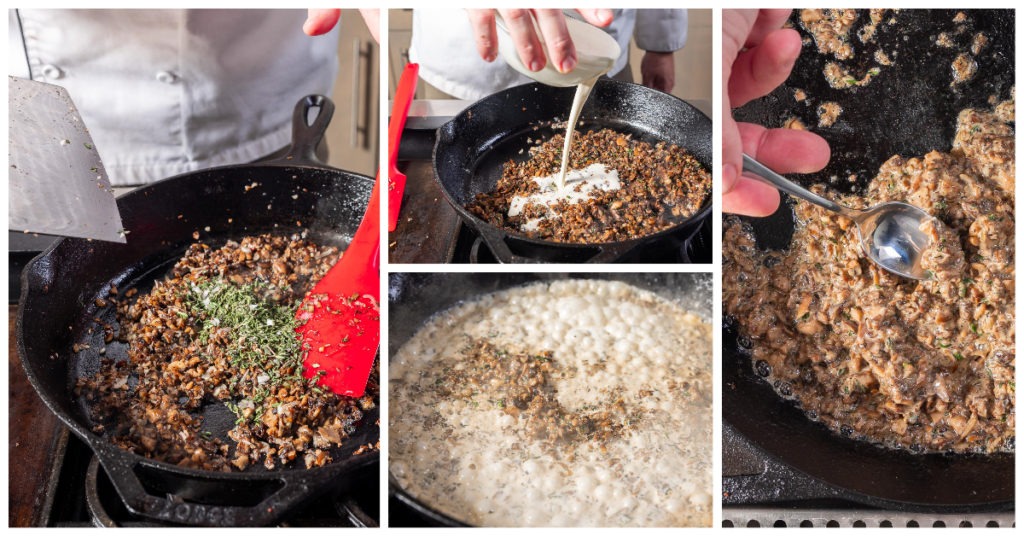
We minced our mushrooms by hand, but that’s not necessary. You can use a food processor for the mincing, but you will need to pre-cut the mushrooms some. Putting whole mushrooms in a food processor can be an exercise in frustration, as they quickly turn into spheres that just roll around on top of the blade. Slice the mushrooms coarsely before adding them to the processor. Work in batches for best results.
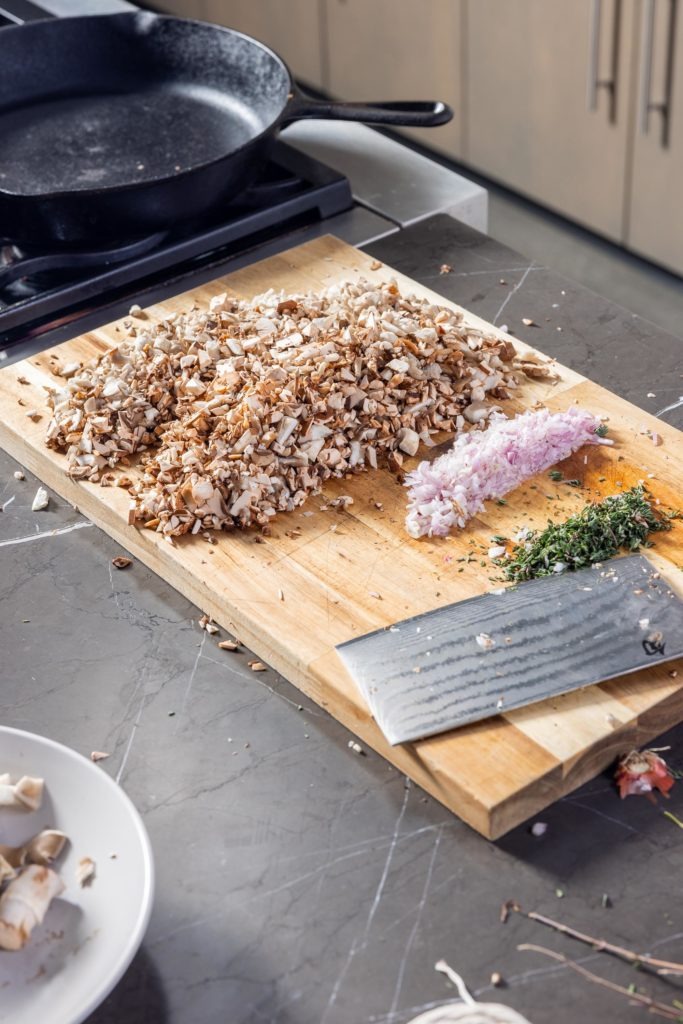
Beef Wellington: thermal properties and why it works
In our post on beef tenderloin, we recommend cooking to perfection by cooking more slowly, in a 225°F (107°C) oven. But for Wellington, we’re adding puff pastry to the mix, which needs an instant hit of high heat to create steam and puff the layers out. Can these two processes be reconciled? Yes.
In truth, they kind of reconcile themselves. We’ll cook the Wellington at 425°F (218°C) to puff the pastry. But we needn’t fear that our beef will overcook too quickly because once the pastry is puffed, it literally becomes a coat of insulation for the meat: all those air pockets slow the flow of heat from the outside to the beef and prevent it from scorching.
Even with that insulating blanket and a few chill cycles for the whole thing, we will still need to monitor the temperature carefully to achieve anything like perfection. Use an RFX MEAT or a ChefAlarm inserted laterally into the loin through the pastry to track the meat’s internal temperature. Set the high alarm to 95–100°F (35–38°C) for perfect medium-rare. (That seems very low, but with the high-heat cook makes for about 25°F of carryover cooking!)
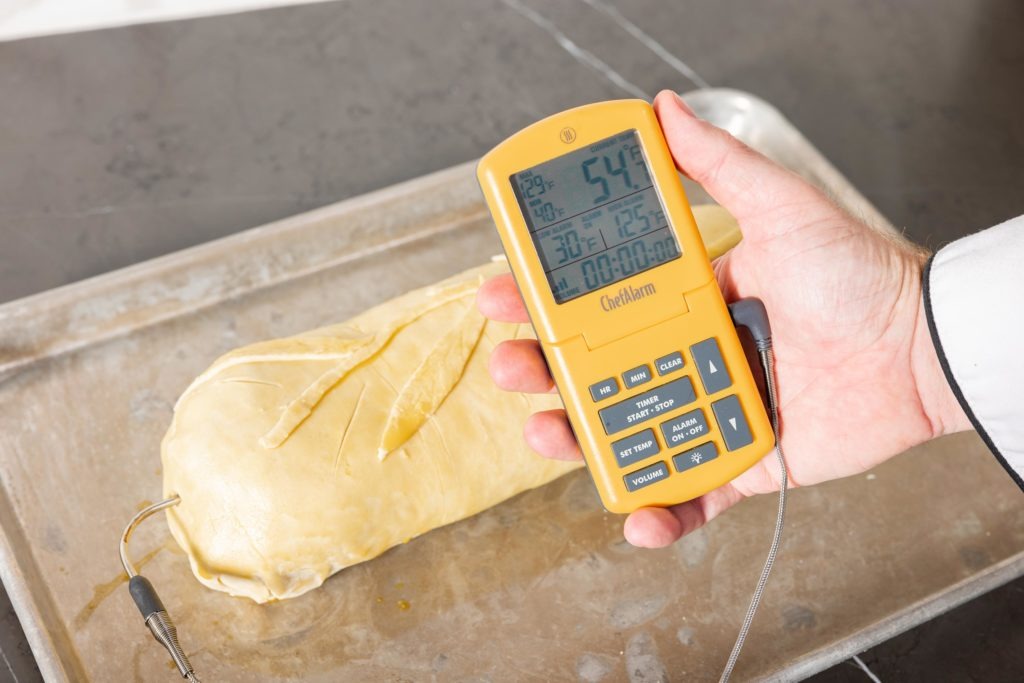
Notes:
- For extra protection from overcooking, do as we recommend in our other tenderloin post, and chill the beef before searing.
- Kenji’s recipe calls for slices of seared whole foie gras, but that’s not an ingredient that is easy to come by in most markets. We substituted pre-made pâté made with foie gras. You may still need to hit up a higher-end grocer or butcher to get it, but it’s much easier to find than a lobe of foie.
- If you’re crazy about DIY, you can make your own puff pastry, but even we’re not going to do that for this dish. Frozen puff pastry is delicious and pretty readily available.
With the holidays coming up, you’re bound to be eating with friends or family at some point. Why not make the occasion a special one with a true centerpiece dish that is out of the ordinary and stunningly delicious? With the help of some thermal tricks (chilling and insulating) and a good thermometer or two (ChefAlarm and Thermapen), you can achieve chef-worthy results that will amaze you and your taste buds, not to mention your family and friends.
Print
Beef Wellington Recipe
Description
Adapted from Based on Ultimate Beef Wellington by SeriousEats.
Ingredients
- 1 center-cut beef tenderloin, trimmed of silverskin and fat, about 2 pounds
- Kosher salt and freshly ground black pepper
- 2 Tbsp vegetable or canola oil
- 3 Tbsp Dijon, spicy brown, or hot English (Coleman’s) mustard
- 1 lb fresh mushrooms (cremini, shiitake, portabello, or, if you’re lucky, chanterelles) cleaned, trimmed, and roughly chopped
- 4 Tbsp unsalted butter
- 2 medium shallots
- 2 tsp finely minced fresh thyme leaves
- 1/2 C cognac or other brandy or barrel-aged spirit such as bourbon
- 1/2 C heavy cream
- 4 oz fresh foie gras (about two 1/2-inch slabs, see note above) or foie gras pâté
- 1 large or 2 small sheets filo dough
- 1/4 lb prosciutto, sliced paper-thin
- Flour for dusting
- 14 oz frozen or homemade puff pastry, thawed (see note)
- 1 egg, beaten
Instructions
Prepare the beef and mushrooms
- A few hours before preparing the dish, remove frozen filo dough and puff pastry from the freezer to allow thawing.
- Tie the beef every inch, season it liberally with salt and pepper, and chill it before searing.
- While beef chills, mince the mushrooms by hand or in a food processor.
- Peel and mince the shallots.
Sear the tenderloin and make the duxelles
- Heat the oil in a heavy skillet over medium-high heat until nearly smoking. Sear the tenderloin on all sides in the pan.
- When the beef is seared, remove it to a plate.
- Reduce the heat in the pan slightly.
- While the beef cools enough to handle, add butter to the pan and melt it, then add the mushrooms to the pan and stir.
- Allow the mushrooms to exude their excess water (a lot of liquid will appear in the pan) and cook it out. Allow the mushrooms to start to brown and maybe stick to the pan a little bit. (See picture below.)
- Meanwhile, trim the strings from the beef and slather it in mustard. Place it in the refrigerator to cool further.
- When the mushrooms are browning, add the shallots and thyme and stir. Cook until the shallots soften somewhat and become well translucent.
- Add the brandy to the mushrooms and cook, stirring some, until the brandy is almost completely cooked out.
- Add the cream and cook, stirring occasionally, until the cream thickens and the whole mass starts acting like one mass in the pan.
- Season to taste with salt and pepper.
- Transfer the duxelles to a shallow dish and refrigerate while the loin chills for 30 minutes.
Create the initial beef roll for the Beef Wellington
- On a wide bed of plastic wrap, lay out the filo dough sheets. If using two smaller ones, lay them out with the long side towards you, overlapping by an inch or two.
- Shingle the prosciutto onto the filo dough, leaving a border 2 inches wide along the top and bottom.
- Remove duxelles from the refrigerator and stir in the foie gras pâté. Spread onto the prosciutto in an even layer.
- Place the tenderloin along the bottom of the ham/shroom layer.
- Using the plastic wrap, roll the tenderloin up in the filo.
- Twist the ends of the wrap tightly like a candy wrapper and tuck them under the package.
- Place the roll in the refrigerator.
Prepare the puff pastry and roll the beef
- Dust your work surface with flour and roll out your puff pastry into a rectangle so that it is 4 inches wider than the length of your meat/filo roll. It should be long enough to go all the way around the circumference of your beef.
- If using pre-sheeted frozen puff pastry, it may be necessary to glue the edges of two sheets together with a little water. Trim any excess and reserve for decorations.
- Place the unwrapped beef roll along the bottom edge of the puff pastry.
- Brush the 6 inches of pastry above the beef roll with egg.
- Carefully roll the beef in the puff pastry until it is wrapped all the way around.
- Trim any excess puff pastry from the bottom so that it isn’t doubled up.
- Fold the ends of the pastry like you are wrapping a present, but trim the bottom flap off.
- Tuck the top flaps under the bottom of the Wellington and return the whole thing to the refrigerator for at least 30 minutes.
Bake the Beef Wellington
- Preheat your oven to 425°F (218°C).
- Remove the Beef Wellington from the refrigerator and brush with egg.
- Add any decorative puff pastry garnishes to the top and sides that you like, then brush them with egg also.
- Score slits in the pastry with a sharp knife or razor.
- Place Beef Wellington on a pan in the oven with an RFX MEAT or a ChefAlarm probe inserted into the short end. Set the high alarm for 100°F (38°C) for medium-rare after carryover.
- Bake until it comes to temperature, leaving the oven door closed the entire time, about 35–45 minutes.
- Verify that your tenderloin has reached its pull-temp with a Thermapen ONE.
- Allow the Beef Wellington to rest for 10 minutes before cutting off the ends and slicing for service.
Shop now for products used in this post:


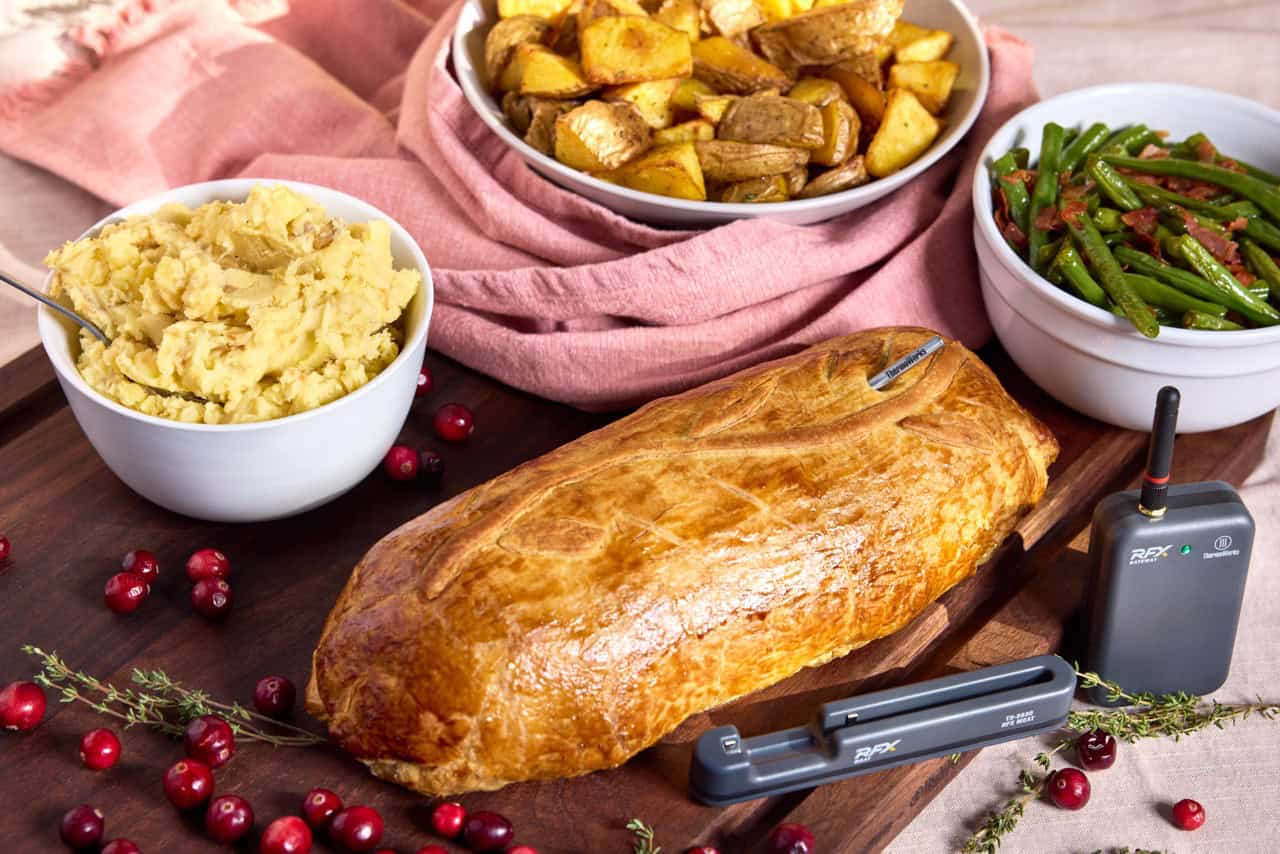
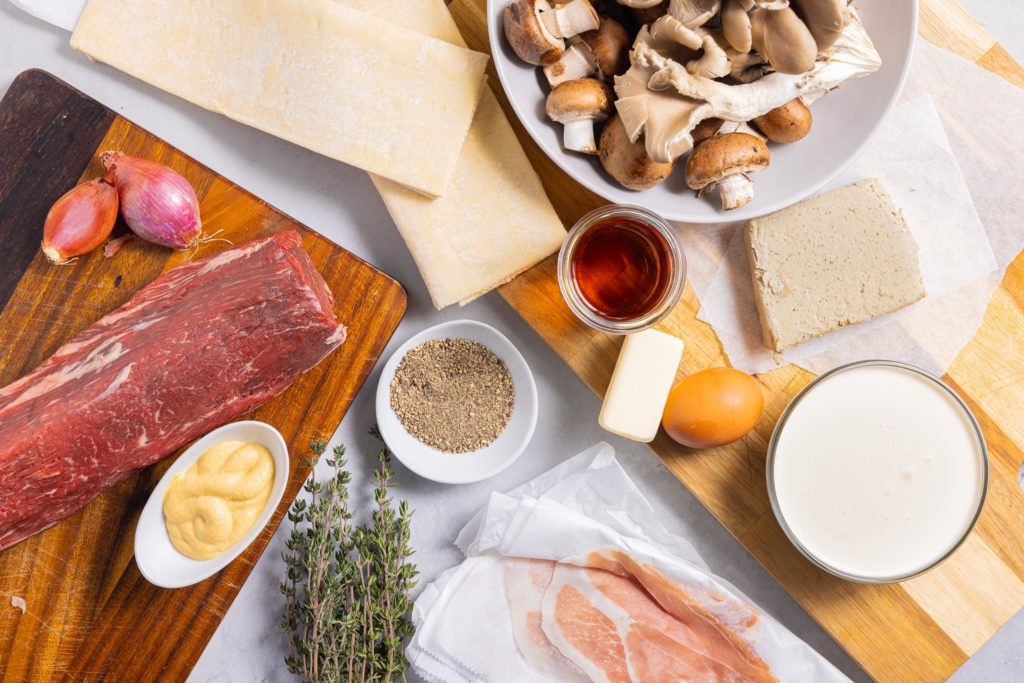
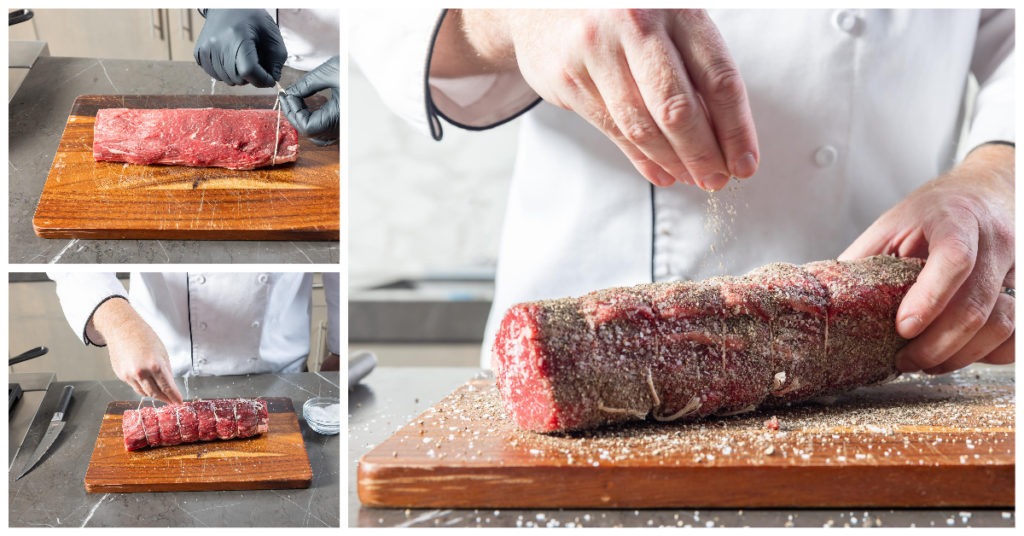
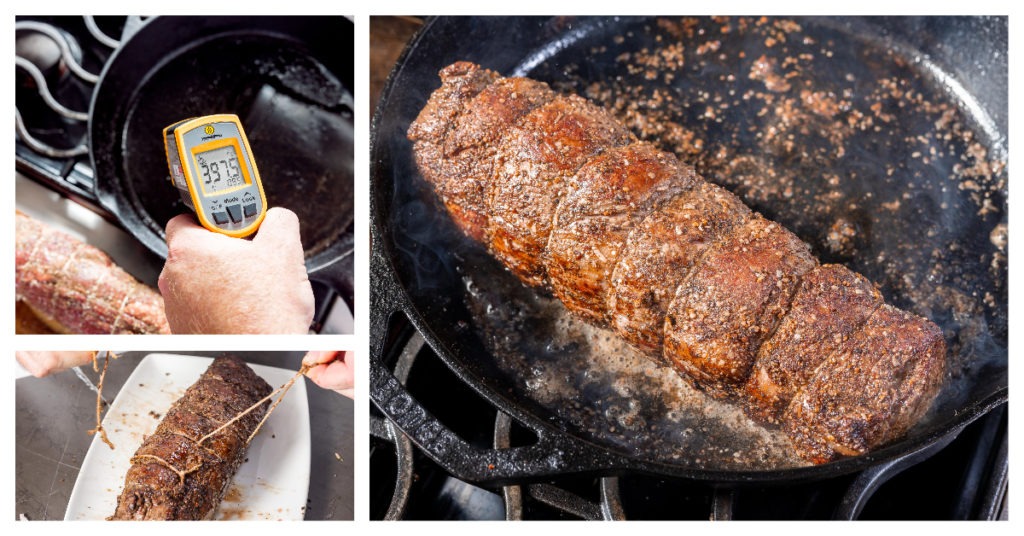
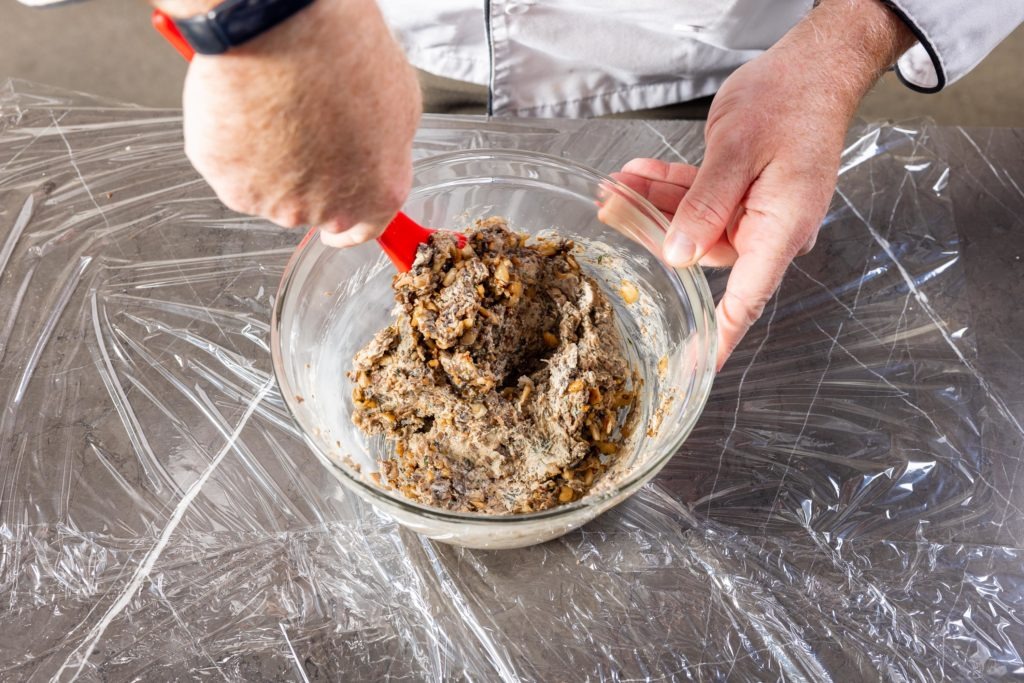

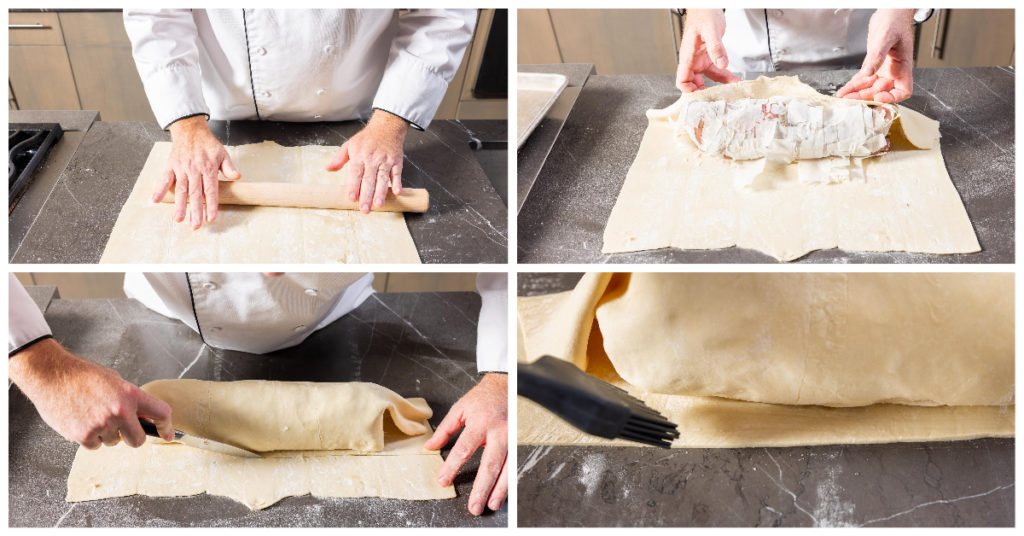
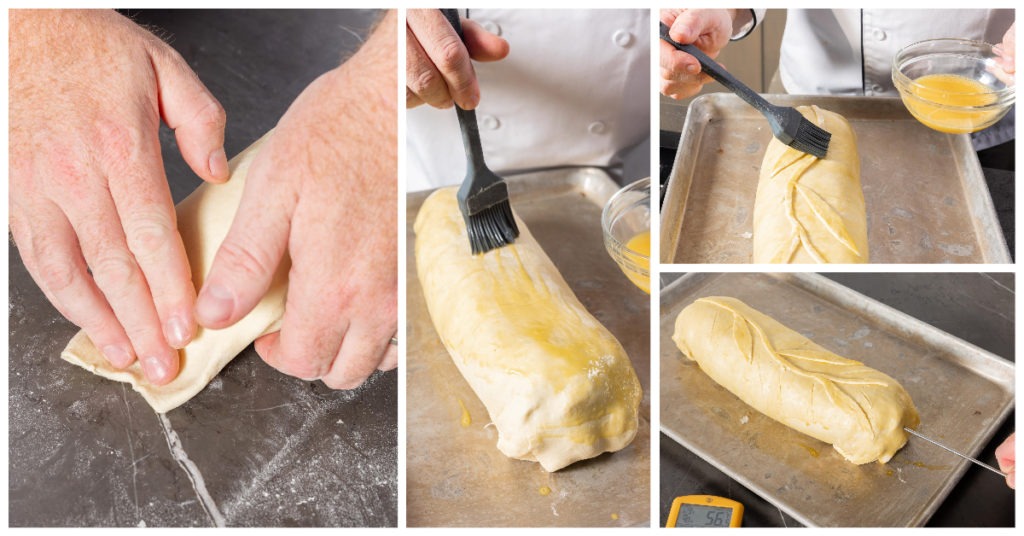
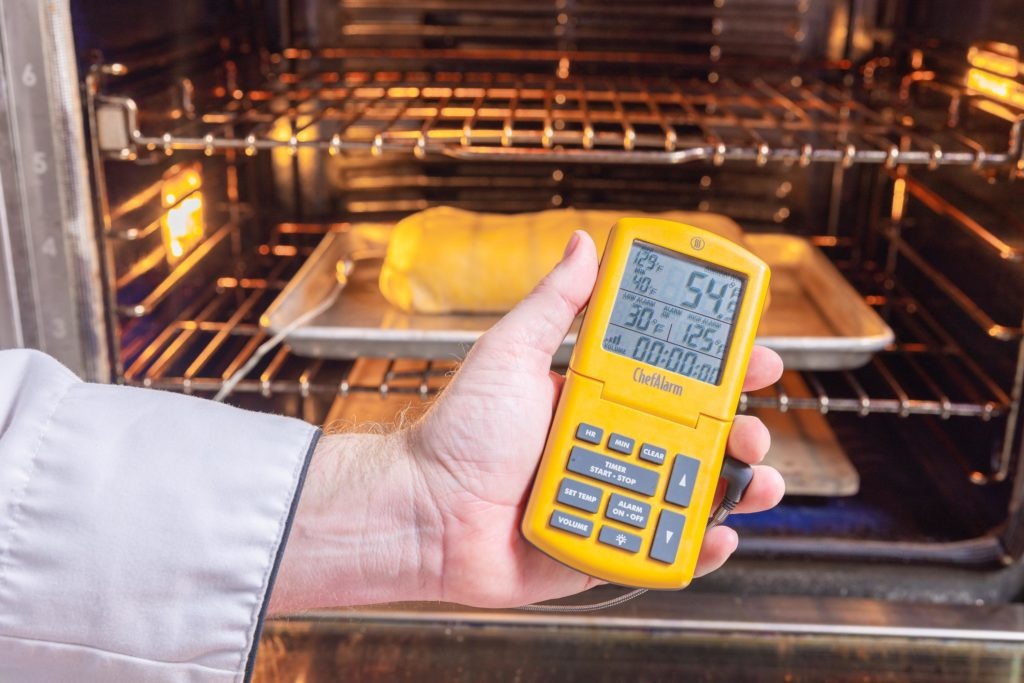

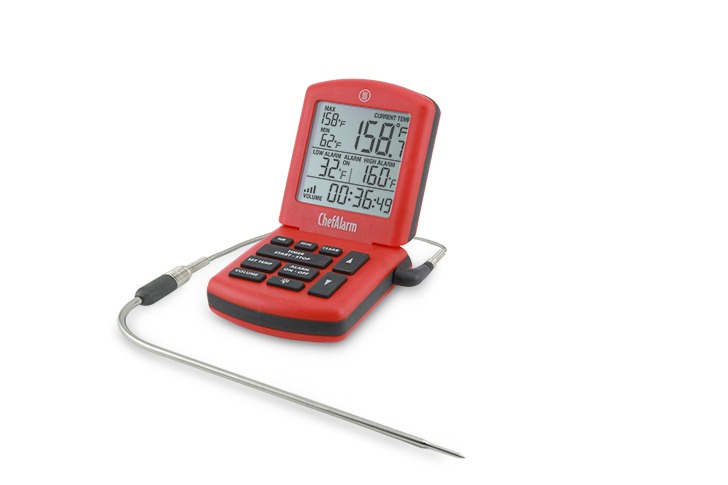
Your instructions are a little vague on making the slits. How many? How deep? The final picture looks as though the slits went through only the puff pastry layer.
Vaughn,
The slits are mostly decorative, but will help to release some steam. 4-5 per side or down the top will be fine, and you should try not to go all the way through the puff, or you’ll get juices dripping out that can spoil the beauty of the finished product.
Give it a try! It’s fantastic.
Can I do all or part of the assembly a day ahead of time? How long do I need to leave out so Middle is medium rare?
Anne,
Yes, the assembly can be done ahead of time. Overnight might be pushing it, but a few hours ahead of time should be fine.
Cooking it to medium rare takes about 35 minutes, but you really should cook it to temperature–125°F for medium rare.
Happy cooking!
Going to try this recipe for the family holiday dinner. Thank you.
“probe inserted into the short end”
I see a circular roll. Which is the sort end?
A local restaurant serves individual portions individually completely covered in pastry. Could you give tips on what to pay particular attention?
Zen,
Yes, that was a vague instruction. DOn’t insert it into the long side or the top, but into one of the two ‘bases” of the cylinder shape.
As for doing individual portions, the process would be very similar but be more vigilant with the searing. Cut thick steaks of tenderloin, chill them very well, sear them, then proceed. But rather than rolling things up, you’re going to be making a packet. Lay a large square of fino, put the prosciutto on it, duxelles, too. Lay the steak in the center and fold corners into the center of the steak, forming a tight-fitting package. When you are ready to put it in the puff pastry, place the packed in the center of a puff square and brush most of the surrounding it with egg. Fold the corners in and crimp them together, using egg as a binder if needed. Chill, brush with egg wash, score for decoration, and cook.
You will want to monitor the temperature even more closely with a ChefAlarm or Smoke because the smaller piece of meat may cook more quickly.
I hope that helps. Happy cooking!
Thank you
Do you keep temperature at 425 degrees all the time?
Yes!
Last year I made it for the very first-time following Gordon Ramsey’s recipe. He does not use foie gras as it is a very controversial product. Foie gras is duck liver. It is made (called gavage in France), by pressure force-feeding geese or ducks in order to enlarge their livers to maximum capacity. It may be banned in some cities or states.
I also substituted a grass-fed standing rib roast minus the ribs, that I rolled for the beef tenderloin as it was less expensive, easier to obtain, and more flavorful than tenderloin. It came out perfectly looking exactly like the photo of Gordon Ramsey’s creation, and was absolutely delicious. His procedure takes two days with the beef resting overnight in the fridge.
What is the purpose of tieing the meat before you sear it?
It helps it to keep a circular, even shape so that it browns and cooks more evenly. Tenderloin is such a tender piece of meat that if you don’t tie it, it will slump down into a roundish triangle shape, and the points of that triangle are more likely to overcook.
I’ve made beef Wellington several times with great success, but I’ve been wondering whether the same technique could be applied to a boneless pork loin (at a fraction of the cost). I just bought whole boneless pork loins for under $2/Lb. If the silver-skin is removed and the meat is cooked to 145-150℉, it seems to me that this might be a terrific, poor-man’s version of the classic version. As with beef, temperature control is essential.
We’ve thought the same thing…It should work great!
Thanks for the very detailed recipe, the result looks great by the way. However, i have 2 questions…how long do you sear it (do you aim a certain temp) and how long do you refrigerate it the first time (before the puff pastry is put on)?
The searing is for browning only, not for heat penetration. We aren’t trying to “cook” it, we’re trying to Maillard-react the surface proteins to make them tastier. Sear each side and the ends until they are well browned. Give it at least 15 minutes in the fridge the first time.
Made it. What a commitment! Whole beef tenderloin was on sale at Fresh Market. Had to learn how to trim and tie it. Thanks, Chef Pierre! Got enough for two Wellingtons, all said and done. Followed your doubled recipe and they both came out fantastic. I carved one for Christmas dinner and the family was amazed. Finished it and they wanted more. That’s when I brought out number two. Heh.
Thanks, Martin. This recipe didn’t disappoint.
Fantastic! I’m so glad you tried it and loved it!